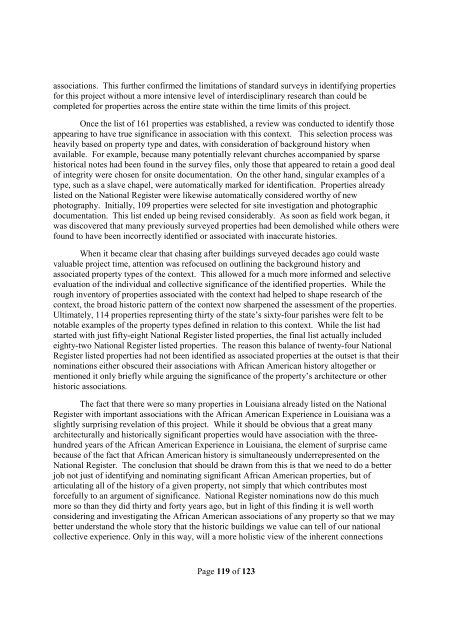The African American Experience in Louisiana
The_African_American_Experience_in_Louisiana
The_African_American_Experience_in_Louisiana
- No tags were found...
You also want an ePaper? Increase the reach of your titles
YUMPU automatically turns print PDFs into web optimized ePapers that Google loves.
associations. This further confirmed the limitations of standard surveys <strong>in</strong> identify<strong>in</strong>g properties<br />
for this project without a more <strong>in</strong>tensive level of <strong>in</strong>terdiscipl<strong>in</strong>ary research than could be<br />
completed for properties across the entire state with<strong>in</strong> the time limits of this project.<br />
Once the list of 161 properties was established, a review was conducted to identify those<br />
appear<strong>in</strong>g to have true significance <strong>in</strong> association with this context. This selection process was<br />
heavily based on property type and dates, with consideration of background history when<br />
available. For example, because many potentially relevant churches accompanied by sparse<br />
historical notes had been found <strong>in</strong> the survey files, only those that appeared to reta<strong>in</strong> a good deal<br />
of <strong>in</strong>tegrity were chosen for onsite documentation. On the other hand, s<strong>in</strong>gular examples of a<br />
type, such as a slave chapel, were automatically marked for identification. Properties already<br />
listed on the National Register were likewise automatically considered worthy of new<br />
photography. Initially, 109 properties were selected for site <strong>in</strong>vestigation and photographic<br />
documentation. This list ended up be<strong>in</strong>g revised considerably. As soon as field work began, it<br />
was discovered that many previously surveyed properties had been demolished while others were<br />
found to have been <strong>in</strong>correctly identified or associated with <strong>in</strong>accurate histories.<br />
When it became clear that chas<strong>in</strong>g after build<strong>in</strong>gs surveyed decades ago could waste<br />
valuable project time, attention was refocused on outl<strong>in</strong><strong>in</strong>g the background history and<br />
associated property types of the context. This allowed for a much more <strong>in</strong>formed and selective<br />
evaluation of the <strong>in</strong>dividual and collective significance of the identified properties. While the<br />
rough <strong>in</strong>ventory of properties associated with the context had helped to shape research of the<br />
context, the broad historic pattern of the context now sharpened the assessment of the properties.<br />
Ultimately, 114 properties represent<strong>in</strong>g thirty of the state’s sixty-four parishes were felt to be<br />
notable examples of the property types def<strong>in</strong>ed <strong>in</strong> relation to this context. While the list had<br />
started with just fifty-eight National Register listed properties, the f<strong>in</strong>al list actually <strong>in</strong>cluded<br />
eighty-two National Register listed properties. <strong>The</strong> reason this balance of twenty-four National<br />
Register listed properties had not been identified as associated properties at the outset is that their<br />
nom<strong>in</strong>ations either obscured their associations with <strong>African</strong> <strong>American</strong> history altogether or<br />
mentioned it only briefly while argu<strong>in</strong>g the significance of the property’s architecture or other<br />
historic associations.<br />
<strong>The</strong> fact that there were so many properties <strong>in</strong> <strong>Louisiana</strong> already listed on the National<br />
Register with important associations with the <strong>African</strong> <strong>American</strong> <strong>Experience</strong> <strong>in</strong> <strong>Louisiana</strong> was a<br />
slightly surpris<strong>in</strong>g revelation of this project. While it should be obvious that a great many<br />
architecturally and historically significant properties would have association with the threehundred<br />
years of the <strong>African</strong> <strong>American</strong> <strong>Experience</strong> <strong>in</strong> <strong>Louisiana</strong>, the element of surprise came<br />
because of the fact that <strong>African</strong> <strong>American</strong> history is simultaneously underrepresented on the<br />
National Register. <strong>The</strong> conclusion that should be drawn from this is that we need to do a better<br />
job not just of identify<strong>in</strong>g and nom<strong>in</strong>at<strong>in</strong>g significant <strong>African</strong> <strong>American</strong> properties, but of<br />
articulat<strong>in</strong>g all of the history of a given property, not simply that which contributes most<br />
forcefully to an argument of significance. National Register nom<strong>in</strong>ations now do this much<br />
more so than they did thirty and forty years ago, but <strong>in</strong> light of this f<strong>in</strong>d<strong>in</strong>g it is well worth<br />
consider<strong>in</strong>g and <strong>in</strong>vestigat<strong>in</strong>g the <strong>African</strong> <strong>American</strong> associations of any property so that we may<br />
better understand the whole story that the historic build<strong>in</strong>gs we value can tell of our national<br />
collective experience. Only <strong>in</strong> this way, will a more holistic view of the <strong>in</strong>herent connections<br />
Page 119 of 123


